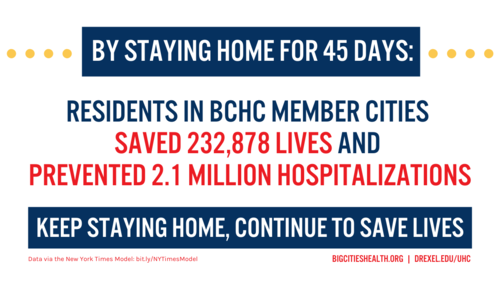BCHC Releases New Estimates on the Impact of Stay At Home Orders

The Big Cities Health Coalition (BCHC) released estimates that show that early actions by BCHC members, leaders from America’s largest metropolitan health departments, to get the public to stay home led to an estimated 2.1 million hospitalizations avoided and over 200,000 lives saved. These estimates, based on 45-day shelter-in-place/stay-at-home orders, were calculated by the Urban Health Collaborative at Drexel University’s Dornsife School of Public Health using a model published by The New York Times.
Additionally, a survey conducted in April by NP Strategy Group found that Americans in all regions of the country understand the impact of stay-at-home orders in place across the nation. It found that, on average, 4 out of 5 (80%) respondents agree that stay-at-home orders helped keep them and their communities healthier and safer during the pandemic, with agreement across age, gender, political and regional breakouts. At the same time, 75% approve of the actions taken by their local public health leaders, and 68% approve of their elected officials’ decisions. Additional poll results are available here.
|
BCHC Member City (Jurisdiction Used in Modeling) |
Estimated Hospitalizations Avoided |
Estimated Lives Saved |
||||
|
Days of Stay at Home
Order |
||||||
|
After 30 Days |
After 45 Days |
After 60 Days |
After 30 Days |
After 45 Days |
After 60 Days |
|
|
Austin (Travis County) |
32,171 |
45,898 |
54,908 |
3,382 |
4,988 |
5,741 |
|
Baltimore City |
15,149 |
21,382 |
24,985 |
1,588 |
2,287 |
2,589 |
|
Boston |
12,523 |
19,670 |
29,242 |
1,310 |
2,032 |
3,030 |
|
Charlotte (Mecklenburg County) |
28,108 |
40,005 |
47,453 |
2,952 |
4,320 |
4,946 |
|
Chicago |
68,254 |
97,575 |
117,206 |
7,187 |
10,635 |
12,269 |
|
Cleveland |
9,692 |
13,828 |
16,542 |
1,019 |
1,503 |
1,730 |
|
Columbus (Franklin County) |
33,253 |
47,441 |
56,753 |
3,496 |
5,155 |
5,934 |
|
Dallas County |
66,556 |
94,954 |
113,593 |
6,997 |
10,318 |
11,876 |
|
Denver |
18,365 |
26,201 |
31,256 |
1,931 |
2,842 |
3,266 |
|
Detroit |
16,987 |
24,236 |
28,993 |
1,745 |
2,634 |
3,031 |
|
Fort Worth (Tarrant County) |
53,096 |
75,751 |
90,365 |
5,583 |
8,215 |
9,441 |
|
Houston |
58,727 |
83,784 |
99,948 |
6,175 |
9,086 |
10,443 |
|
Indianapolis (Marion County) |
24,388 |
34,752 |
41,340 |
2,562 |
3,761 |
4,314 |
|
Kansas City |
12,423 |
17,723 |
21,143 |
1,306 |
1,922 |
2,209 |
|
Las Vegas (Clark County) |
58,205 |
81,666 |
94,463 |
6,097 |
8,682 |
9,752 |
|
Long Beach |
11,873 |
16,838 |
19,831 |
1,246 |
1,811 |
2,062 |
|
Los Angeles County |
253,522 |
362,610 |
436,656 |
26,702 |
39,613 |
45,762 |
|
Miami-Dade County |
68,777 |
97,888 |
116,113 |
7,224 |
10,572 |
12,103 |
|
Minneapolis |
10,782 |
15,327 |
18,116 |
1,132 |
1,652 |
1,886 |
|
New York City |
141,958 |
226,728 |
288,724 |
15,188 |
24,062 |
30,876 |
|
Oakland (Alameda County) |
42,664 |
60,216 |
70,364 |
4,473 |
6,441 |
7,291 |
|
Philadelphia |
40,003 |
57,072 |
68,275 |
4,206 |
6,202 |
7,138 |
|
Phoenix (Maricopa County) |
114,769 |
161,603 |
187,879 |
12,032 |
17,263 |
19,437 |
|
Portland (Multnomah County) |
20,527 |
29,286 |
35,034 |
2,159 |
3,183 |
3,663 |
|
San Antonio (Bexar County) |
52,932 |
75,426 |
89,723 |
5,562 |
8,163 |
9,364 |
|
San Diego County |
84,304 |
120,579 |
145,202 |
8,879 |
13,172 |
15,217 |
|
San Francisco |
22,503 |
31,761 |
37,112 |
2,359 |
3,397 |
3,845 |
|
San Jose (Santa Clara County) |
49,212 |
69,453 |
81,161 |
5,159 |
7,429 |
8,409 |
|
Seattle-King County |
56,891 |
81,165 |
97,097 |
5,981 |
8,819 |
10,151 |
|
Washington, D.C. |
18,015 |
25,427 |
29,711 |
1,888 |
2,719 |
3,078 |
|
Total BCHC Member Jurisdictions |
1,496,629 |
2,156,245 |
2,589,188 |
157,520 |
232,878 |
270,853 |
On Methodology
The template for the estimation calculations was based on methodology developed by Community Information Now
From The New York Times: Note that this is a model, not the real world; epidemiologists say that in reality the virus without controls would take longer to spread, partly because of growing immunity and partly because people would become much more careful. We are using the S.E.I.R. (Susceptible, Exposed, Infected and Resistant) model; this differs from a model we previously published because it also considers a latency period, when an infected person is not yet contagious. The weather calculation is based on a seasonality formula from a paper about the coronavirus in Swiss Medical Weekly. This model was adapted from a version developed by the mathematician Gabriel Goh (with assistance from Steven De Keninck, another mathematician), modified for Times Opinion with the guidance of the epidemiologists Ashleigh Tuite and David N. Fisman from the University of Toronto. While we reveal many of the variables in the tool itself, we also made several assumptions based on the best available estimates for the coronavirus: the incubation period is set to 5.2 days; the infectious period is set to 2.9 days; recovery is assumed to take 11.1 days for mild cases and 28.6 days for severe cases; time to death is estimated to be 32 days; we also assume a delay of five days before infected patients visit a hospital.